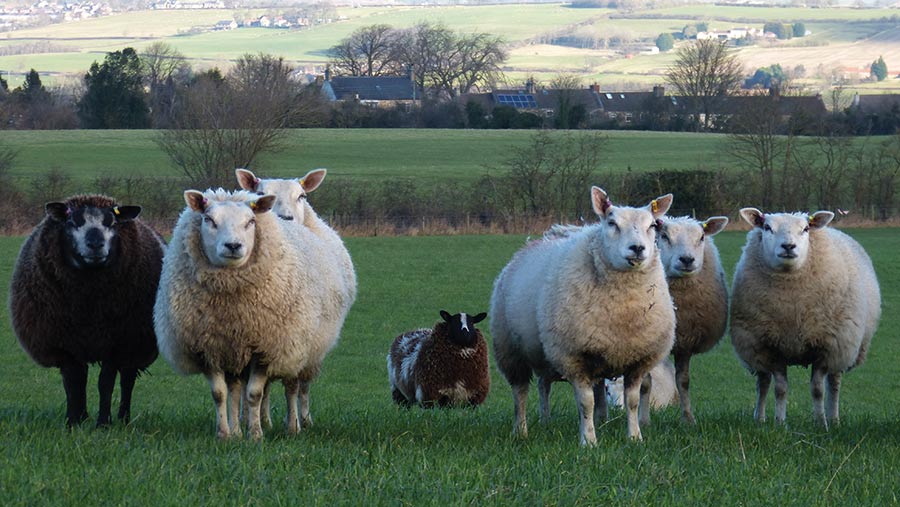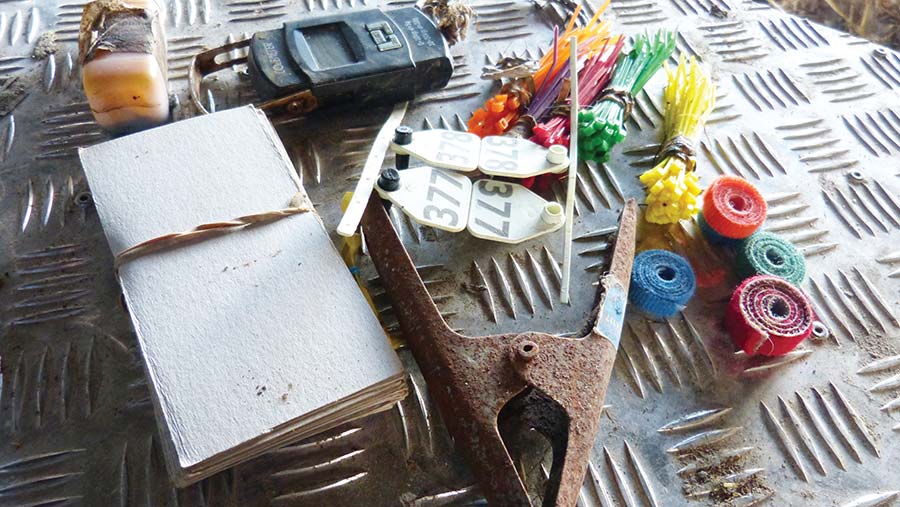How lambing data helps closed flocks run smoother
 Home-bred ewe lambs ready to lamb in March at Greenfield © MAG/Michael Priestley
Home-bred ewe lambs ready to lamb in March at Greenfield © MAG/Michael Priestley A desire to safeguard flock health has seen a recent trend for closed flocks. This has been helped by the ability to monitor individual ewe and sire performance through ear tag tracking software.
While tens of thousands of commercial cross-breds are sold every autumn and remain a key feature of many flying flock systems, some farms are selecting from sheep challenged in their own environment.
However ewes spend their winter, the ability to hold condition as a dry sheep is vital to having the strength to lamb easily and produce sufficient milk and colostrum.
See also: Closed policy yields 1.7 lambs reared for Durham flock
This is according to independent livestock geneticist Janet Roden of Harper Adams University and Innovis.
Assessing body condition score (BCS) and checking ewes are holding condition from weaning to tupping, tupping to scanning, scanning to the next handling time (such as vaccinations), and then lambing is important, she says.
Holding condition might not be the first trait you select for, but eventually it will become more of a priority. Lowland sheep should have a BCS of 3 at lambing, she adds.
Farmers Weekly asked Janet what traits to consider selecting for at lambing time:
1. Birthweight: 0.13 heritability
Collecting birth weights can help remove extremes from the flock. The ideal is a lamb that is big and strong enough to thrive, but not too big to cause lambing challenges.
This is probably of moderate importance, depending on the level of intervention your system offers at lambing time.
2. Lamb suckling assistance: 0.04 heritability
Intensive lambing sheds may be set up for feeding and assisting suckling, but flock managers running a more hybrid or outdoor system may want to minimise this.
Innovis scores (scale of 1-4, with 4 being high intervention) for the level of assistance needed, which helps find genetic lines that thrive without intervention.
3. Maternal behaviour: 0.05 heritability
Recording any sheep that reject or headbutt lambs, and not breeding from their offspring, will improve maternal behaviour over time. Innovis uses a 1-3 scoring system, with higher numbers being poorer.
Focus on the quality of the ewe’s attention to her lamb, rather than the shepherd (or the dog or bike, if outdoors). The ewe might have been fine had she not been startled.
4. Lambing ease: 0.21 heritability for sires, 0.06 for ewes
Ease of lambing is affected by the ewe and the ram.
The ewe’s ability to grow a lamb and the size of her pelvis are important, as is the sire’s genetic influence on the growth of that lamb through the gestation period. Record the ewes needing assistance as a starting point.
While they might stay in the flock if this is their only weakness, you might consider not breeding from any of their progeny.
Tips for getting lambing data for a closed flock
A range of techniques are used by Jayne Lovegreen and partner Kristen Butters, who lamb 300 ewes in eight weeks from 6 March alongside their full-time jobs at Northumbrian Water.
Software
The Herdwatch app is used to track culling offences, medicine book details and lamb performance
Weighing scales
Lamb weights are taken and recorded on Herdwatch and electronic identification (EID) tags are fitted.
Birthweights are used to improve weight gain accuracy to weaning and beyond, so poor milkers can be culled.
If any patterns can be seen in high- or low-birthweight lambs, these lines can be highlighted not to breed from.
Pen cards
Cards are used to record date of birth, weight, sex of lambs, litter size (twins and triplets are bred for), lambing difficulty, slow lambs and mothering issues.
Velcro tags
Three colours are used: white (top up with milk), red (lambs to remove) and orange (adoption). Using these tags saves time when recording data, as well as being a clear way of sharing information.
Whiteboard
Any questions or issues such as medical intervention and antibiotics use, maternal ability or lamb survival can be written on the whiteboard, so Jayne can assess a ewe herself and log the intervention on the Herdwatch app.
Coloured cable ties
The flock does single-sire mating, which allows tracking of sire performance. Each sire is assigned a colour, making it easy to see how his lambs perform that year.
Management tags
Large ear tags are given to shearlings as they lamb, and lambs are stock-marked with the corresponding number. This number is entered into the Herdwatch app to help monitor sheep at grass.

© MAG/Michael Priestley
Case study: Jayne Lovegreen, High Etherley, County Durham
Terminal sired prime lamb producer Jayne Lovegreen uses software and simple lambing shed cards to put her continental-cross ewes through a rigorous process at each lambing.
The flock at Greenfield Farm, near Bishop Auckland, has been as closed to outside genetics as physically possible after having a maedi visna (MV) scare and inadvertently buying resistant parasite Teladorsagia circumcincta onto the farm.
MV tests were inconclusive on a ram the farm had bought, which was enough of a fright, explains Jayne, who also runs a small Hereford herd on the family’s 62ha (153-acre) ring-fenced farm.
“We probably won’t even buy tups in this year,” she says.
“We have four home-bred tups: one Beltex ram lamb, two Blue Texels and a Dutch Spotted. We use Beltex a lot but try and balance it out with a Charollais or a Suffolk occasionally, to maintain frame and size.”
Any rams that are bought in will be blood-tested for iceberg diseases and quarantined for three to four weeks.
